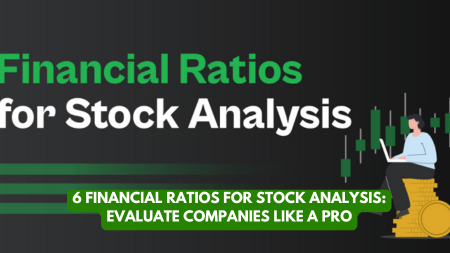No products in the cart.
Stock Market
6 Financial Ratios for Stock Analysis: Evaluate Companies Like a Pro
6 Financial Ratios for Stock Analysis: Evaluate Companies Like a Pro

Effectively evaluating stocks is critical for making informed investment decisions. Financial ratios are powerful tools that help investors assess a company’s performance, financial health, and valuation. By understanding and utilizing these ratios, investors in the Philippines can analyze companies like professionals. This comprehensive guide explores six essential financial ratios, providing in-depth explanations, calculation methods, interpretation guidelines, and practical applications.
Valuation Ratios: Understanding Company Worth

Price-to-Earnings (P/E) Ratio
The price-to-earnings (P/E) ratio is one of the most widely used metrics for valuing a company. It compares the current share price to the company’s earnings per share (EPS).
Formula and Calculation
Copy
P/E Ratio = Market Price per Share / Earnings per Share (EPS)
How to Interpret P/E Ratio
- High P/E Ratio: Indicates that investors expect high growth in the future. Companies with strong growth prospects often command higher P/E ratios.
- Low P/E Ratio: Could indicate an undervaluation of the stock or difficulties facing the company. Value investors often look for companies with low P/E ratios relative to their industry or historical levels.
- Industry Comparison: Always compare a company’s P/E ratio to others in the same industry, as different sectors have different typical P/E ranges.
Real-World Application
- A company with a P/E ratio of 15 indicates that investors are willing to pay PHP 15 for every PHP 1 in earnings.
- In the Philippine context, companies in high-growth sectors like technology might have P/E ratios of 20-30, while more established industries like banking might have lower P/E ratios of 10-15.
Limitations
- P/E ratios don’t account for company debt levels
- They can be misleading for companies with irregular earnings
- Companies with negative earnings don’t have a meaningful P/E ratio
Price-to-Book (P/B) Ratio
The price-to-book (P/B) ratio compares a company’s market price to its book value (net asset value).
Formula and Calculation
Copy
P/B Ratio = Market Price per Share / Book Value per Share
How to Interpret P/B Ratio
- P/B < 1: Suggests a potential undervaluation of the stock. The market values the company at less than the accounting value of its assets.
- P/B > 1: Indicates that the stock analysis may be overvalued or that the company has robust growth prospects. Investors are willing to pay a premium over the company’s net asset value.
- Industry Specific: Different industries have different capital requirements and expected P/B ratios.
Real-World Application
- A P/B ratio of 0.8 means the stock analysis is trading at 80% of its book value.
- Property companies and banks in the Philippines often trade at P/B ratios closer to their book value due to their asset-heavy nature.
Advanced Analysis
- Compare P/B with Return on Equity (ROE) for a more comprehensive analysis
- Examine trends in P/B over time to identify potential investment opportunities
- Consider the quality of assets on the balance sheet
Financial Health Ratios: Assessing Company Stability
Debt-to-Equity (D/E) Ratio
The debt-to-equity (D/E) ratio measures a company’s financial leverage by comparing its total liabilities to its shareholders’ equity.
Formula and Calculation
Copy
D/E Ratio = Total Liabilities / Shareholders’ Equity
How to Interpret D/E Ratio
- High D/E Ratio: Indicates higher financial risk due to increased debt levels. Companies with D/E ratios above 2.0 may face higher interest expenses and financial vulnerability.
- Low D/E Ratio: Suggests a more conservative approach with less reliance on debt. A D/E ratio below 0.5 often indicates financial stability.
- Industry Considerations: Capital-intensive industries typically have higher D/E ratios than service industries.
Real-World Application
- A D/E ratio of 0.5 means the company has PHP 0.50 of debt for every PHP 1 of equity.
- In the Philippines, utilities and telecommunications companies often operate with higher D/E ratios due to their stable cash flows and capital requirements.
Risk Assessment Framework
- Evaluate D/E alongside interest coverage ratio for comprehensive debt analysis
- Consider debt maturity profiles and refinancing risks
- Assess debt denomination (PHP vs. foreign currencies) for exposure to exchange rate fluctuations
Current Ratio
The current ratio assesses a company’s ability to pay its short-term obligations with its short-term assets.
Formula and Calculation
Copy
Current Ratio = Current Assets / Current Liabilities
How to Interpret Current Ratio
- Current Ratio > 1: Indicates that the company is able to meet its short-term obligations. A ratio of 1.5-2.0 is generally considered healthy.
- Current Ratio < 1: Indicates potential liquidity problems. The company may struggle to meet its short-term obligations.
- Trend Analysis: The trend of the current ratio over time is often more revealing than a single value.
Real-World Application
- A current ratio of 2 means the company has PHP 2 in current assets for every PHP 1 in current liabilities.
- For retailers in the Philippines, seasonal fluctuations in inventory can affect the current ratio throughout the year.
Enhanced Liquidity Analysis
- Compare with the quick ratio (excludes inventory) for a stricter liquidity test
- Examine cash flow statements alongside the current ratio
- Assess quality and liquidity of current assets
Profitability Ratios: Measuring Efficiency and Returns
Return on Equity (ROE)
Return on equity (ROE) measures a company’s profitability by comparing net income to shareholders’ equity.
Formula and Calculation
Copy
ROE = Net Income / Shareholders’ Equity
How to Interpret ROE
- High ROE: Indicates efficient use of equity to generate profits. An ROE above 15% is generally considered good.
- Low ROE: Suggests less efficient use of equity. Companies with ROE below the industry average may be underperforming.
- DuPont Analysis: Breaking down ROE into profit margin, asset turnover, and financial leverage provides deeper insights.
Real-World Application
- An ROE of 15% means the company generates PHP 0.15 in profit for every PHP 1 of equity.
- In the Philippine market, well-managed banks often maintain ROEs between 10-15%.
Strategic Interpretation
- Compare ROE to the company’s cost of equity to assess value creation
- Analyze ROE trends over multiple years to identify sustainable performance
- Consider the impact of one-time events on ROE calculations
Dividend Yield
The dividend yield indicates the annual dividend payment as a percentage of the stock’s current price.
Formula and Calculation
Copy
Dividend Yield = Annual Dividend per Share / Market Price per Share
How to Interpret Dividend Yield
- High Dividend Yield: Attractive for income-focused investors, but could indicate a high-risk stock analysis or limited growth prospects if significantly above market average.
- Low Dividend Yield: Indicates lower dividend income but possibly higher growth potential. The company may be reinvesting profits for future growth.
- Payout Analysis: Consider the dividend payout ratio alongside the yield for sustainability assessment.
Real-World Application
- A dividend yield of 4% means the company pays PHP 4 annually for every PHP 100 invested in the stock.
- Philippine telecommunications and utility companies often offer higher dividend yields, sometimes ranging from 4-6%.
Dividend Strategy Considerations
- Evaluate dividend growth history and consistency
- Assess the company’s free cash flow to support dividend payments
- Consider the impact of special dividends on the calculation
Integrating Financial Ratios into Investment Analysis
Sector-Specific Considerations
Different industries have different “normal” ranges for financial ratios. Understanding sector-specific benchmarks helps place individual company ratios in context.
Banking Sector
- Focus on net interest margin, loan-to-deposit ratio, and non-performing loan ratio
- Lower acceptable P/B ratios compared to other sectors
- Capital adequacy ratios as regulatory requirements
Manufacturing Sector
- Inventory turnover and accounts receivable turnover become critical
- Higher capital expenditure needs reflected in balance sheet ratios
- Operational efficiency ratios like gross margin
Property Sector
- Net asset value per share is a key valuation metric
- Recurring income vs. development income analysis
- Debt service coverage ratio for financial stability
Combining Ratios for Comprehensive Analysis
Growth and Value Assessment
- Compare P/E ratio with the company’s earnings growth rate (PEG ratio)
- Assess P/B ratio alongside ROE to identify potential value opportunities
- Evaluate dividend yield in relation to earnings growth
Financial Stability Framework
- Analyze D/E ratio together with interest coverage ratio
- Compare current ratio with industry cash conversion cycles
- Assess working capital management efficiency
Performance Evaluation Matrix
- ROE in conjunction with profit margins and asset turnover
- Dividend yield alongside dividend payout ratio and earnings retention
- Capital allocation efficiency metrics
Practical Application in the Philippine Market
Using Ratios to Screen Stocks
- Setting ratio thresholds for initial stock screening
- Creating a ranking system based on multiple financial ratios
- Building watchlists of companies meeting specific criteria
Comparative Analysis Techniques
- Comparing a company’s ratios to industry peers
- Tracking ratio trends over multiple quarters and years
- Benchmarking against market leaders and sector averages
Red Flags and Warning Signs
- Sudden deterioration in key financial ratios
- Inconsistencies between related ratios
- Ratios that significantly deviate from industry norms
Conclusion

Understanding and applying these financial ratios can help Filipino investors make more informed decisions and evaluate companies more effectively. By analyzing the P/E ratio, P/B ratio, D/E ratio, current ratio, ROE, and dividend yield, investors can gain insights into a company’s valuation, financial health, and profitability.
These ratios should not be used in isolation but rather as part of a comprehensive investment analysis framework. Consider industry specifics, company growth stage, management quality, and broader economic conditions alongside financial ratios. Regularly using these ratios in your investment analysis can enhance your ability to identify attractive investment opportunities and build a robust portfolio tailored to the Philippine market.
Remember that historical ratios are backward-looking, while investing is forward-looking. Use these tools to inform your decisions, but also consider qualitative factors and future prospects when evaluating potential investments.
READ MORE RELATED BLOGS!
READ MORE AND SHARE!
TSOK Chronicles: Unleashing Passion, Dedication, and Excellence in 2024
2023 Your Practical Wedding Guide
Investments and Finance Ultimate Guide
If you like this article please share and love my page DIARYNIGRACIA PAGE Questions, suggestions send me at diarynigracia@gmail.com
You may also follow my Instagram account featuring microliterature #microlit. For more of my artworks, visit DIARYNIGRACIA INSTAGRAM
 Skip to content
Skip to content

Peace and love to you.